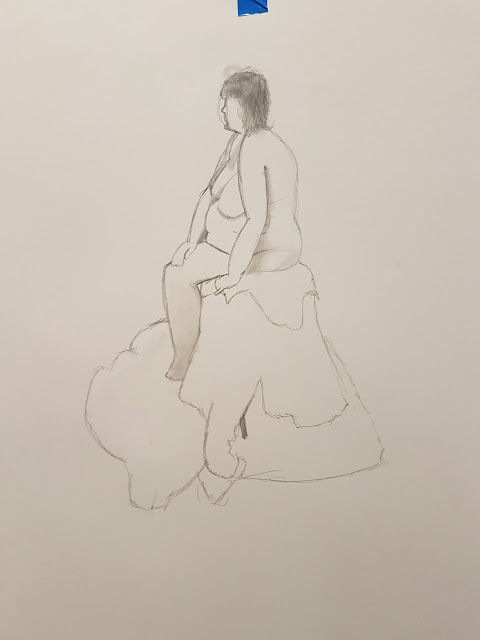 |
| Fig 1. Suspiria Poster, 1977 |
Suspiria (Argento, 1977) is a film about an American Ballet dancer who travels to Germany to study at a prestigious dance academy. But soon, she discovers the school is really a front for a series of dark murders by a coven of evil witches.
 |
| Fig 2. Suspiria (1977) |
One things this film does well is convey an underlying sense of dread throughout. There is always a very strong use of the colour red in this film, from the outside of the building, to the main hallway and rooms within the building (see Fig 2). The colour Red is quite often used in cinema to depict desire, and also danger/suspense, and this film in a way depicts both of those with its striking set pieces - in the first instance, the girls have a passion to be the best dancer/performer in the school, and the underlying danger of the possibility of any one of the students being killed at any time.
We can see in Fig 3 that the main character, Suzy, is in the office of the dance academy. The red hue that has been applied to the scene helps emphasise to us that she is either currently in danger, or that she is about to be.
We can see in Fig 3 that the main character, Suzy, is in the office of the dance academy. The red hue that has been applied to the scene helps emphasise to us that she is either currently in danger, or that she is about to be.
"And then there's Argento's masterful use of deep primary colours — the sets are bathed in garish red and green light (he acquired 1950s Technicolor stock to get the effect) giving the whole film a hallucinatory intensity."
(Smith, 2000)
This quote not only provides background information on how the hues were achieved, but reinforces the notion that the goings-on in the film are very surreal and dream-like, almost to a fault.
Something the film does differently to normal is prey on our drowsiness and dream-like states when watching the piece. It makes us more susceptible to being shocked by the goings-on in the film, but particularly with Suspiria, in that we, like Suzy, have a difficult time discerning between what is really happening and what is a figment of imagination.
This quote is playing upon the fact that, when we are in a dream state, we do things we normally wouldn't. We'll just ignore or dismiss anything that would normally be considered strange, like choose to walk along a road barefoot rather than take a bus, or stay at a ballet school where people are disappearing and being killed left, right and centre. Argento is a master craftsman when it comes to Horror films, making sure to lure everyone into a false sense of security, and strike at the most opportune moment.
Suspiria, like many other films, uses an amazing score to complement the footage on screen. The soundtrack for Suspiria was written by the Italian band "Goblin", and creates a constant sense of unease throughout.
 |
| Fig 3. Suspiria (1977) |
Something the film does differently to normal is prey on our drowsiness and dream-like states when watching the piece. It makes us more susceptible to being shocked by the goings-on in the film, but particularly with Suspiria, in that we, like Suzy, have a difficult time discerning between what is really happening and what is a figment of imagination.
"But unlike so many lazy films that simply position its characters to advance a plot no matter what, Argento is aware that we are at our most curious when we are asleep"
(Hall, 2016)
Suspiria, like many other films, uses an amazing score to complement the footage on screen. The soundtrack for Suspiria was written by the Italian band "Goblin", and creates a constant sense of unease throughout.
"In a film where character are stalked, observed, and hunted, this score is a signifier that you are not alone"
(Hall, 2016)
Every horror film's soundtrack needs to be distinguishable, contrary to the old adage of "the best soundtrack is one that isn't noticeable". It needs to be able to heighten your state of wariness, keeping you on the edge of your seat at all times. Suspiria's soundtrack does just this, with it oftentimes being quite brash and loud, but never to the point of it being comical. Every piece of music ties in well with the lighting and set design, to make you feel continually apprehensive of what will happen next.
Bibliography:
- Smith, A. (2015). Suspiria. Retrieved December 20, 2016, from http://www.empireonline.com/movies/suspiria/review/
- Hall, J. (2016, February). Suspiria Review: A Bad Dream Made Real. Retrieved December 21, 2016, from http://www.slashfilm.com/suspiria-review/2/
- Hall, J. (2016, February). Suspiria Review: A Bad Dream Made Real. Retrieved December 21, 2016, from http://www.slashfilm.com/suspiria-review/3/
- Fig 1.: Suspiria (1977) [Poster] At: http://civilianglobal.com/images/sized/suspiriaposter_625_900.jpg?c2336f
- Fig 2.: Suspiria (1977) From: Suspiria, Seda Spettacoli. Directed by: Dario Argento [Film Still] Italy: Seda Spettacoli
- Fig 3.: Suspiria (1977) From: Suspiria, Seda Spettacoli. Directed by: Dario Argento [Film Still] Italy: Seda Spettacoli













































